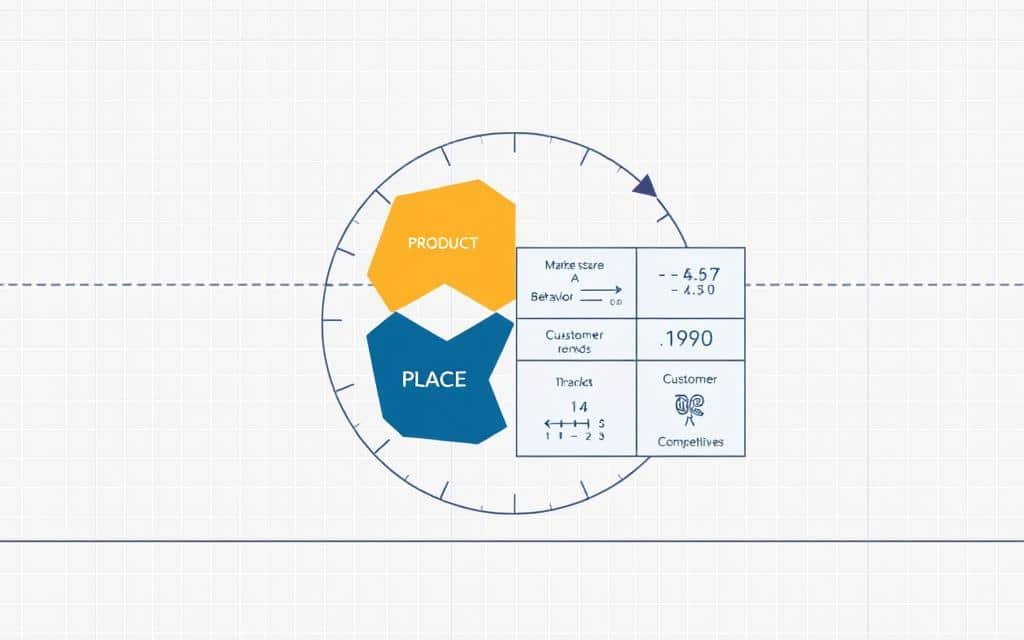In today’s crowded advertising landscape, rising costs and shrinking data visibility leave many teams guessing which campaigns actually drive results. Marketing mix modeling (MMM) cuts through the noise by analyzing historical performance across channels like TV, digital, and print. This approach transforms raw numbers into clear insights, helping you allocate budgets smarter—even as privacy changes reshape measurement.
With aggregated data from past campaigns, MMM reveals how each channel contributes to sales or brand growth. It answers critical questions: Did your latest social media push deliver real value? How much should you invest in streaming ads versus email? As consumer journeys grow fragmented, this methodology bridges gaps left by disappearing cookies and platform silos.
Key Takeaways
- MMM uses historical data to measure campaign effectiveness across channels.
- Identifies budget waste and high-performing strategies in dynamic markets.
- Works around privacy changes by analyzing aggregated, non-personal data.
- Provides clarity on how TV, digital, and print efforts impact outcomes.
- Helps optimize spending decisions amid rising advertising costs.
Overview of Marketing Mix Modeling in Modern Advertising
As consumer touchpoints multiply and measurement tools evolve, teams struggle to connect spending to outcomes. Traditional metrics fail to capture how channels like streaming ads or in-store promotions collectively drive growth. Modern approaches now prioritize aggregated data analysis to navigate privacy shifts and platform fragmentation.
The Changing Landscape of Advertising
Three forces reshape how brands measure success. Rising costs demand precise budget allocation—wasting funds on underperforming channels hurts profitability. Platform complexity grows as new social networks and ad formats emerge monthly. Meanwhile, cookie deprecation limits granular tracking, pushing teams toward broader performance analysis.
| Factor | Traditional Approach | Modern MMM Solution |
|---|---|---|
| Data Sources | Last-click attribution | Cross-channel impact modeling |
| Privacy Adaptation | Individual tracking | Aggregate trend analysis |
| Channel Complexity | Isolated performance reviews | Integrated sales influence scoring |
| Budget Allocation | Historical averages | Scenario-based forecasting |
Rise of Data-Driven Decision Making
You can’t optimize what you don’t measure. By analyzing years of campaign results, modeling techniques reveal hidden patterns. For example, a retail chain might discover email campaigns drive 31% more in-store sales than previously thought—a finding impossible through platform-specific metrics alone.
This approach turns guesswork into strategy. When seasonal promotions overlap with social media efforts, aggregated data shows true incremental gains. Teams reallocate funds confidently, knowing each dollar targets high-impact channels.
The Fundamentals of Marketing Mix Modeling
Decades before digital dashboards dominated boardrooms, teams relied on intuition to guide spending choices. Today’s approach combines statistical rigor with real-world business context, transforming raw numbers into actionable plans.

Historical Context and Evolution
The concept originated in the 1960s when E. Jerome McCarthy introduced the 4Ps framework (Product, Price, Place, Promotion). Early iterations used basic regression analysis to estimate advertising impact. Technological advances now enable granular tracking of cross-channel synergies.
Core Components and Metrics
Modern MMM evaluates three pillars: media investment patterns, consumer behavior trends, and external market factors. Key metrics include:
| Aspect | 1980s Approach | 2020s Approach |
|---|---|---|
| Data Sources | TV ratings & sales receipts | Omnichannel engagement signals |
| Key Metrics | GRP (Gross Rating Points) | Incremental ROI + Brand Lift |
| Analysis Frequency | Quarterly | Real-time adjustments |
| Strategy Impact | Generic budget shifts | Precision reallocation |
You’ll notice performance measurement now balances immediate sales impact with long-term brand equity. Streaming ad impressions might drive quick conversions, while billboard placements strengthen market position over time.
This methodology helps craft strategies that withstand economic shifts. By isolating variables like seasonal demand or competitor pricing, MMM reveals which efforts actually move the needle.
Deep Dive: what do marketing mix models show advertisers
Understanding which efforts yield tangible returns separates thriving brands from stagnant competitors. Marketing mix modeling dissects historical campaign data to expose hidden patterns in channel performance. This analysis answers critical questions: Does your TikTok spend drive more conversions than YouTube pre-roll ads? How do holiday promotions amplify email marketing effectiveness?
Channel Effectiveness Analysis
Historical data reveals surprising truths. A beverage company discovered 44% of summer sales came from digital display ads—triple their initial estimates. Another brand found podcast sponsorships underperformed despite high engagement metrics.
| Channel | Contribution to Sales | Key Influencing Factors |
|---|---|---|
| Amazon Ads | 28% | Seasonal demand spikes |
| Connected TV | 15% | Primetime ad placements |
| Email Campaigns | 19% | Personalization rate |
| Influencer Marketing | 9% | Audience alignment |
Three elements shape these results: campaign timing, audience targeting precision, and external market conditions. A retail chain improved ROI by 23% after adjusting social media schedules to match regional shopping trends.
Insights for Strategic Budget Reallocation
Data-driven shifts create measurable impact. When analysis shows paid search hits diminishing returns at $50k/month, reallocating funds to high-growth channels like streaming audio makes strategic sense.
Consider these real-world adjustments:
- A cosmetics brand shifted 18% of TV budgets to Amazon Ads, boosting Q4 sales by 31%
- An auto dealer reallocated 40% of print spend to localized digital ads, increasing test drives by 27%
These insights help maintain balance between immediate sales drivers and long-term brand building. Regular modeling updates ensure budgets adapt to changing consumer behaviors and competitive pressures.
Optimizing Budget Allocation and Maximizing ROI
Every dollar counts when balancing immediate sales goals with long-term growth. Marketing mix modeling pinpoints exactly where your investment loses steam—and where to double down for maximum impact.

Understanding Diminishing Returns
Spending more doesn’t always mean earning more. Channels like social media ads often hit performance ceilings. One retailer discovered boosting Facebook spend beyond $80k/month yielded just $1.10 per dollar—half their baseline ROI.
Key metrics reveal these thresholds:
| Channel | Optimal Monthly Spend | iROAS Beyond Limit |
|---|---|---|
| Paid Search | $120k | 0.8x |
| Streaming Ads | $65k | 1.4x |
| Email Marketing | $45k | 2.1x |
Leveraging Incrementality in Campaigns
True value lies in measuring what wouldn’t happen without your investment. A CPG brand shifted 22% of display ad budgets to connected TV after analysis showed 3x higher incremental sales lift.
Three steps drive smarter decisions:
- Compare mROI across channels weekly
- Reallocate 10-15% of underperforming budgets monthly
- Balance brand-building (60-day impact) with quick-win tactics
This approach helped a tech company boost annual profits by 18% while maintaining customer acquisition targets. Regular analytics reviews keep your spend aligned with shifting market conditions.
Integrating Traditional and Digital Marketing Channels
Blending legacy media with digital tactics creates measurement gaps that leave teams flying blind. By merging TV ratings, billboard impressions, and social engagement data, you unlock a complete view of customer journeys. Campaign effectiveness hinges on connecting these dots—a coffee chain boosted sales 24% after linking radio ads to mobile app usage spikes.
Combining Offline and Online Data Sources
Traditional channels still drive 37% of conversions for retail brands. The challenge lies in tracking how newspaper inserts influence Google searches. One home goods company solved this by:
- Matching postal codes of print ad distributions with website traffic
- Correlating TV ad airtimes with branded search volume
- Using promo codes in radio spots to track in-store redemptions
| Data Type | Collection Method | Role in Analysis |
|---|---|---|
| TV GRPs | Nielsen ratings | Baseline brand exposure |
| Digital CTRs | Platform APIs | Immediate engagement |
| In-Store Sales | POS systems | Final conversion proof |
Aligning Multi-Touch Attribution with MMM
Multi-touch attribution (MTA) reveals which campaign touchpoints started conversions. MMM shows how media spend drives market-level results. Together, they answer “Who clicked?” and “What moved the needle?”
A car manufacturer combined both methods to discover:
| Approach | Insight | Budget Impact |
|---|---|---|
| MTA | YouTube ads initiated 42% of test drives | +19% video spend |
| MMM | Radio ads amplified dealership foot traffic by 28% | +15% audio allocation |
Adjusting attribution windows remains critical. While MTA tracks 30-day paths, MMM analyzes 90-day brand effects. Sync these timelines to avoid allocation errors during quarterly planning cycles.
Advanced Analytical Techniques and Data Integration
Modern analytics transform raw campaign data into strategic foresight. By combining predictive tools with refined data hygiene practices, teams unlock precision in budget decisions and trend anticipation.
Utilizing Predictive Analytics and Forecasting
AI-powered tools simulate 12-month scenarios in minutes. These systems analyze seasonal patterns, competitor moves, and economic indicators to forecast outcomes. A beverage brand improved Q4 sales predictions by 19% using machine learning models that factored in weather trends.
| Traditional Forecast | AI-Driven Approach |
|---|---|
| Linear projections | Multi-variable simulations |
| Monthly updates | Real-time adjustments |
| +/- 15% accuracy | +/- 6% error margin |
Three steps enhance your approach:
- Feed models with 3+ years of campaign results
- Test scenarios against market shocks
- Align predictions with quarterly business outcomes
Handling Outliers and Missing Data Effectively
Anomalies distort insights. When a viral TikTok post skewed a retailer’s social media metrics, robust filtering isolated true campaign impact. Techniques like regression imputation fill data gaps while preserving trends.
Best practices include:
- Flagging data points 2.5 standard deviations from the mean
- Using time-series analysis to spot irregular patterns
- Validating cleansed data against industry benchmarks
These methods ensure your marketing mix model reflects reality—not noise. One fintech firm boosted forecast accuracy by 27% after implementing outlier detection protocols.
Implementing MMM: Challenges, Best Practices and Strategic Tips
Building an effective marketing strategy requires confronting messy data and conflicting metrics head-on. Your team might struggle with incomplete sales records or mismatched attribution windows across different marketing platforms. These hurdles distort your view of channel performance.
Overcoming Data and Attribution Obstacles
Gaps in historical data plague 73% of MMM implementations. A footwear brand solved this by blending 5 years of store receipts with mobile app engagement metrics. Their mix model revealed email campaigns drove 22% more in-store traffic than estimated.
| Challenge | Solution | Impact Example |
|---|---|---|
| Missing TV ad spend data | Use Nielsen ratings as proxy | Improved accuracy by 18% |
| Conflicting attribution models | Weighted average reconciliation | Reduced allocation errors by 31% |
| Real-time vs historical metrics | Dynamic calibration algorithm | Boosted forecast precision by 24% |
Regular model updates prevent strategy decay. One retailer reviews their marketing channels mix quarterly, adjusting for:
- Seasonal demand shifts
- New platform adoption rates
- Competitor spend patterns
“Blending MMM with multi-touch attribution helped us resolve 89% of conflicting channel performance reports.”
To make informed decisions, establish clear data governance protocols. Standardize metrics across different marketing teams and validate findings against third-party benchmarks. This approach keeps your marketing strategy aligned with actual market conditions.
Conclusion
Navigating today’s fragmented media environment requires more than intuition. Marketing mix modeling delivers actionable clarity, transforming scattered data into strategic roadmaps. By revealing which efforts drive real growth, it helps teams optimize marketing investments while avoiding costly guesswork.
Effective budget allocation hinges on understanding channel synergies and diminishing returns. Shifting funds from underperforming tactics to high-impact platforms—like reallocating 20% of traditional ad spend to streaming campaigns—can boost ROI by double digits.
Long-term success stems from balancing immediate gains with sustainable brand building. Regular analysis of aggregated data ensures spending adapts to market shifts, privacy changes, and emerging channels. This approach turns uncertainty into confidence.
Your next move? Apply these insights to optimize marketing plans using evidence-based budget allocation. The result: smarter spending, measurable outcomes, and resources focused where they matter most.